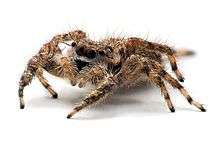Scopulae
Scopulae, or scopula pads, are dense tufts of hair at the end of a spiders's legs. They are found mostly on hunting spiders, especially Lycosidae and Salticidae. Scopulae consist of microscopic hairs, each covered in even smaller hairs called setules or "end feet", resulting in a large contact area.
When the scopulae are splayed out and placed against a surface, remarkable adhesion is produced due to the accumulation of adhesion of each individual setule interacting with a substrate. The adhesion may be due to the excretion of liquid from adhesive pads, although setae can adhere in both dry and wet modes.[1] This enables spiders with scopulae to climb even sheer, smooth surfaces such as glass. The adhesion is so great that the spider could grip using this force and support 170 times its own weight. Possible physical mechanisms may include capillary, electrostatic, viscous, or Van der Waals force. (Niederegger et al 2002; Betz and Kölsch, 2004)[2]
Scopulae are found in addition to, not instead of, the claws at the end of each appendage, called tarsal claws.
References
- ↑ Peattie, A. Dirks, J. Henriques, S. and W. Federle. 2011. Arachnids secrete a fluid over their adhesive pads. PLoSOne 6(5): e20485.
- ↑ https://www.tandfonline.com/doi/pdf/10.1080/19768354.2009.9647208?needAccess=true
